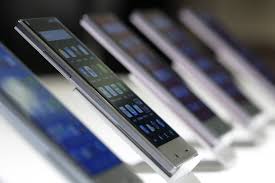IPhone Screen Makers Are Tanking on a Report that Apple Is Switching to Displays They Can’t Make

The shares of some iPhone display suppliers fell in Asia after South Korea’s Electronic Times reported that Apple (aapl) has decided to use next-generation screens for all of its new models next year, even though several analysts said such a transition wasn’t likely.
Japan Display shares fell as much as 21%, the biggest intraday drop since its 2014 market debut. Sharp Corp. (shcay) declined as much as 4.3%. If true, Apple’s move would be negative for both manufacturers, which have so far been unable to mass produce OLEDs and currently supply LCD screens. Representatives for Apple, JDI and Sharp declined to comment.
A shift to using only organic light-emitting diode screens for iPhones would be challenging, given the sheer volume that Apple sells: 216 million devices in 2017. Samsung Display Co., part of Samsung Electronics Co. (ssnlf), is the sole supplier of OLED screens for high-end Apple phones, but the manufacturer also uses them for its own smartphones, limiting supplies. While Apple has embraced OLED, most analysts said they don’t see the switch happening in 2019.
“It is unlikely that Apple will be releasing three OLED models next year,” said Jeff Pu, an analyst at Taipei-based Yuanta Securities Investment Consulting. The other major OLED supplier, LG Display Co. (lpl), has struggled to move into mass production and isn’t likely to boost OLED production for Apple in 2019 from 5 million to 10 million units expected this year, he said.
Still, LG Display shares rose as much as 5.9% on the Electronic Times report, the biggest intraday gain in four months. Samsung was down 1.5 percent. A representative for Samsung Display declined to comment.
One of three new iPhones models last year featured an OLED screen. Apple is on track to use OLED in two of three new models later this year. The Electronic Times report suggests a full OLED lineup next year.
“Ultimately, the plan is for Apple to go full OLED on its iPhones as far as I know but whether that’s going to happen at this point is a question mark,” said Jerry Kang, a senior principal analyst at IHS Markit based in Bundang, South Korea. “Apple hasn’t been able to expand on its iPhone X production because of market demand and price issues.”
Indeed, the cost of OLED technology has been a major concern. Sales of the iPhone X with an OLED screen were crimped by its starting price of $ 999. Moving to all OLED screens next year would make it difficult to keep iPhones affordable for mass market consumers.
Organic light-emitting diode screens have been embraced as the future of smartphones because they’re crisper and use less power than their liquid-crystal predecessors. They cost more, and can also be problematic. Users of Google’s Pixel smartphone have complained of inaccurate color reproduction and burn-in, where images remain after the screen is turned off. Apple warns on its website that burn-in and slight color changes are “characteristic” of OLED panels.
Arthur Liao, an analyst at Taipei-based Fubon Securities, wrote in a note that he has not heard anything about Apple switching to all OLED models next year from the supply chain in Taiwan.
Apple is also working on its own technology for displays, people with knowledge of the plans have said. Called MicroLED, the screens use different light-emitting compounds than the current OLED displays and promise to make future gadgets slimmer, brighter and less power-hungry.
